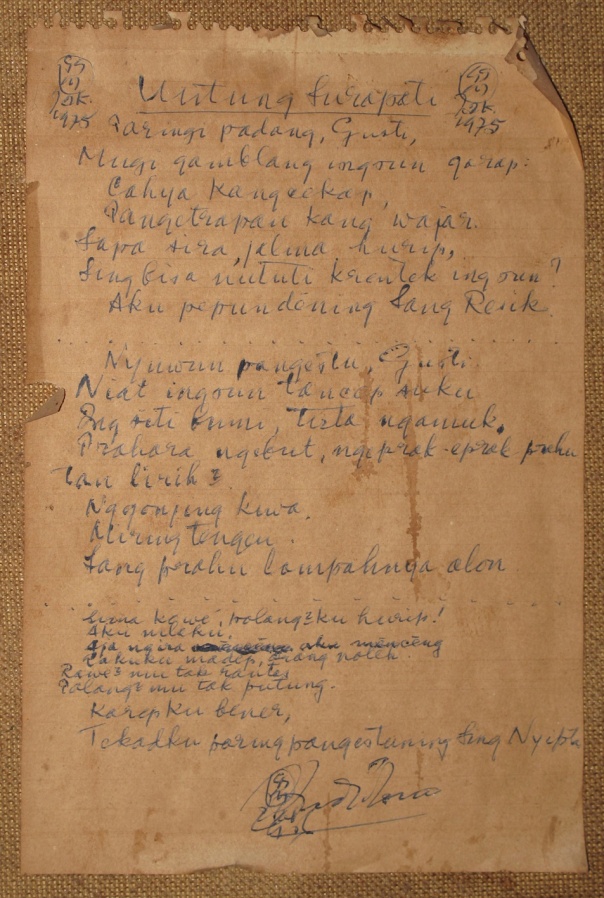This is S. Sudjojono’s interpretation of Untung Suropati, an historical character who happened to be honored as an Indonesian national hero in 1975. It seems that the character might have caught Sudjojono’s attention when he was doing research for the large mural about Sultan Agung’s 1628-29 unsuccessful siege of Batavia (completed 1974), displayed at the Jakarta History Museum on Taman Fatahilah.
According to the epic Babad Tanah Jawi, Untung Suropati was a slave who originated from Bali. A Dutch officer by the name of Moor attributed the rise his career and the increase of his wealth to his acquisition of his new slave, and decided to call him “Untung” (which means “fortune”).
Later, when he found out that Untung and his daughter Suzanne were getting involved deeper and deeper in a love affair, he decided to imprison him. However Untung gathered his prison mates and managed to escape from prison and became fugitives.
Untung eventually acquired the named Surapati from the Sultan of Cirebon. He went on to Kartasura, where he was kept under the aegis of Sultan Amangkurat II. Untung Surapati was best known for killing Captain Tack, a Dutch officer who was sent to Kartasura to capture him, in 1686.
Untung Surapati went on to become the ruler of Pasuruan, still under the auspices of Sultan Amangkurat II. Following the Sultan’s death in 1703, his successor Amangkurat III came in conflict with Pangeran Puger (a son of Amangkurat I) and fled to Pasuruan. When the Dutch forces launched an attack on Pasuruan in 1706, Surapati retreated to Bangil, where he was killed. Amangkurat III continued to fight the Dutch with Surapati’s sons until their surrender in 1708.
A piece of paper with Sudjojono’s text is affixed on to the reverse of the canvas:
Untung Suropati
Paringi padang, Gusti
Mugi gamblang ingsun garap
Cahya kangcekap
Pangetrapan kang wajar
Sapa sira, jalma hurip
Sing bisa nututi krentek ingsun
Aku pepundening Sang Resik,
- - - - - -
Nyuwun pangestu, Gusti
Niat ingsun tancap suku
Ing siti bumi, tirta ngamuk
Prahara ngebut, ngeprak-eprak prahu
lan lirik2,
Nggonjing kiwa,
Miring tengen
Sang prahu lampahnya alon
- - - - - -
Sirna kowe, polang2ku hurip
Aku mlaku
Aja ngira, aku menceng,
Lakuku ngadep, orang noleh,
Rawe2mu tak rantas
Palang2mu tak putung
Karepku bener,
Tekadku paring pangestaning Sang Nyipta
S. Sudjojono
Jak, 1975
The text seems to be a kind of evocation to The Almighty, so that he will remain on track in pursuit of truth. He uses the metaphor of a journey on a boat or ship through rough waters to portray life. In the painting, Untung Suropati is depicted as if he were on a boat together with his love Suzanne.
It seems clear that Sudjojono identified himself with Untung Suropati, who like him, fell in love with a European woman. Be that as it may, Untung Suropati continued to fight against the colonialists in pursuit of freedom, and it is apparent that Sudjojono intended to follow this example.
For the e-catalog, click here: http://www.sidharta.co/fa2013/

